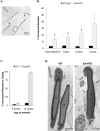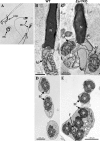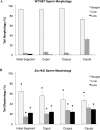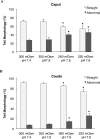Epididymal hypo-osmolality induces abnormal sperm morphology and function in the estrogen receptor alpha knockout mouse
- PMID: 20130266
- PMCID: PMC2857636
- DOI: 10.1095/biolreprod.109.080366
Epididymal hypo-osmolality induces abnormal sperm morphology and function in the estrogen receptor alpha knockout mouse
Abstract
Estrogen receptor-alpha (ESR1) is highly expressed in the efferent ductules of all species studied as well as in the epididymal epithelium in mice and other select species. Male mice lacking ESR1 (Esr1KO) are infertile, but transplantation studies demonstrated that Esr1KO germ cells are capable of fertilization when placed in a wild-type reproductive tract. These results suggest that extratesticular regions, such as the efferent ductules and epididymis, are the major source of pathological changes in Esr1KO males. Previous studies have shown alterations in ion and fluid transporters in the efferent duct and epididymal epithelia of Esr1KO males, leading to misregulation of luminal fluid pH. To determine the effect of an altered epididymal milieu on Esr1KO sperm, we assayed sperm morphology in the different regions of the epididymis. Sperm recovered from the epididymis exhibited abnormal flagellar coiling and increased incidence of spontaneous acrosome reactions, both of which are consistent with exposure to abnormal epididymal fluid. Analysis of the epididymal fluid revealed that the osmolality of the Esr1KO fluid was reduced relative to wild type, consistent with prior reports of inappropriate fluid absorption from the efferent ductules. This, along with the finding that morphological defects increased with transit through the epididymal duct, suggests that the anomalies in sperm are a consequence of the abnormal luminal environment. Consistent with this, incubating Esr1KO sperm in a more wild-type-like osmotic environment significantly rescued the abnormal flagellar coiling. This work demonstrates that Esr1KO mice exhibit an abnormal fluid environment in the lumen of the efferent ducts and epididymis, precluding normal sperm maturation and instead resulting in progressive deterioration of sperm that contributes to infertility.
Figures








Similar articles
-
Absence of estrogen receptor alpha leads to physiological alterations in the mouse epididymis and consequent defects in sperm function.Biol Reprod. 2010 May;82(5):948-57. doi: 10.1095/biolreprod.109.079889. Epub 2010 Feb 3. Biol Reprod. 2010. PMID: 20130267 Free PMC article.
-
Role for Nongenomic Estrogen Signaling in Male Fertility.Endocrinology. 2024 Jan 16;165(3):bqad180. doi: 10.1210/endocr/bqad180. Endocrinology. 2024. PMID: 38066676 Free PMC article.
-
Membrane-Localized Estrogen Receptor 1 Is Required for Normal Male Reproductive Development and Function in Mice.Endocrinology. 2016 Jul;157(7):2909-19. doi: 10.1210/en.2016-1085. Epub 2016 May 4. Endocrinology. 2016. PMID: 27145009 Free PMC article.
-
Contribution of epididymal secretory proteins for spermatozoa maturation.Microsc Res Tech. 2003 May 1;61(1):7-17. doi: 10.1002/jemt.10312. Microsc Res Tech. 2003. PMID: 12672118 Review.
-
Delineating the role of estrogen in regulating epididymal gene expression.Soc Reprod Fertil Suppl. 2007;63:31-43. Soc Reprod Fertil Suppl. 2007. PMID: 17566259 Review.
Cited by
-
Exploring edible bird nest's potential in mitigating Wi-Fi's impact on male reproductive health.Reprod Med Biol. 2024 Sep 11;23(1):e12606. doi: 10.1002/rmb2.12606. eCollection 2024 Jan-Dec. Reprod Med Biol. 2024. PMID: 39263384 Free PMC article.
-
Network pharmacology integrated molecular docking reveals the bioactive components and potential targets of Morinda officinalis-Lycium barbarum coupled-herbs against oligoasthenozoospermia.Sci Rep. 2021 Jan 26;11(1):2220. doi: 10.1038/s41598-020-80780-6. Sci Rep. 2021. PMID: 33500463 Free PMC article.
-
An Integrated Analysis of Network Pharmacology, Molecular Docking, and Experiment Validation to Explore the New Candidate Active Component and Mechanism of Cuscutae Semen-Mori Fructus Coupled-Herbs in Treating Oligoasthenozoospermia.Drug Des Devel Ther. 2021 May 17;15:2059-2089. doi: 10.2147/DDDT.S307015. eCollection 2021. Drug Des Devel Ther. 2021. PMID: 34040346 Free PMC article.
-
Distinct actions of testicular endocrine and lumicrine signaling on the proximal epididymal transcriptome.Reprod Biol Endocrinol. 2024 Apr 10;22(1):40. doi: 10.1186/s12958-024-01213-x. Reprod Biol Endocrinol. 2024. PMID: 38600586 Free PMC article.
-
Loss of SED1/MFG-E8 results in altered luminal physiology in the epididymis.Mol Reprod Dev. 2010 Jun;77(6):550-63. doi: 10.1002/mrd.21189. Mol Reprod Dev. 2010. PMID: 20422713 Free PMC article.
References
-
- Cooper TG.Role of the epididymis in mediating changes in the male gamete during maturation. Adv Exp Med Biol 1995; 377: 87–101. - PubMed
-
- Moore HD, Bedford JM.Short-term effects of androgen withdrawal on the structure of different epithelial cells in the rat epididymis. Anat Rec 1979; 193: 293–311. - PubMed
-
- Moore HD, Bedford JM.The differential absorptive activity of epithelial cells of the rat epididymus before and after castration. Anat Rec 1979; 193: 313–327. - PubMed
-
- Robaire B, Seenundun S, Hamzeh M, Lamour SA.Androgenic regulation of novel genes in the epididymis. Asian J Androl 2007; 9: 545–553. - PubMed
-
- Meistrich ML, Hughes TH, Bruce WR.Alteration of epididymal sperm transport and maturation in mice by oestrogen and testosterone. Nature 1975; 258: 145–147. - PubMed
Publication types
MeSH terms
Substances
Grants and funding
LinkOut - more resources
Full Text Sources
Molecular Biology Databases
Miscellaneous

